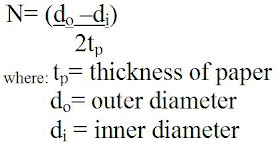If you have a good understanding of math or don't care about the proof, skip to the end. If you're curious to the method behind the result, keep reading.
The basis of this method lies in the formula for a circle based on the diameter:
EQ. 1: Circumference = π* diameter
What we're doing when we roll paper into a tube is stacking a lot of thin walled tubes together to form a solid one. The goal is to make a formula to add up all the lengths of paper that consist of each individual tube together, so we can simply measure a length, roll it up around an object, and make a tube of the approximate dimensions.
I've been making my ball joints out of 3.175 mm (1/8") diameter bamboo sticks. For this example, I'll be using that as a baseline inner diameter for my measurements. You can choose to use other inner diameters later on. My goal for this example is to generate an 8mm diameter cylinder/sphere. First, I need to calculate how many times I'll need to wrap my strip of paper around this stick. Unfortunately, I need a vital measurement that most of you will be hard pressed to find: the thickness of paper. Fortunately, I've done that work for you.
Thickness of 110lb cardstock is roughly 0.252095 mm (or 0.009925"), calculated by a series of measurements, averaged to compensate for the lack of a digital caliper. (Dial calipers do have their drawbacks, but I love watching the spinning dial when I use mine.) Regular printer paper is roughly 0.004" to 0.005" for reference. You may notice, I kept all the decimals as far out as possible. I did this since the later part is going to vary a lot based on how accurate my values are.
Now. To the formulas! Time to pay attention to the equations, page skimmer! The number of revolutions your strip will need to make is:
 You'll get a non-whole number. That's fine. Your revolved solid may be a bit thicker on one side than the other, but if you're aiming to make precise paper Rolexes, you shouldn't be learning from a guy who inhales Magic: the Gathering card dust on a daily basis.
You'll get a non-whole number. That's fine. Your revolved solid may be a bit thicker on one side than the other, but if you're aiming to make precise paper Rolexes, you shouldn't be learning from a guy who inhales Magic: the Gathering card dust on a daily basis.Armed with this number, we're going to mess with arithmetic series. As we add a layer of paper, we're incrementally adding a length of paper proportional to the thickness and a constant. The thickness of paper is the change in diameter we're adding, and based off our formula earlier for the circumference, we're changing the circumference with each increment of the diameter. That gives us:
 Where C is the circumference, N is the number of revolutions you need to make. Each revolution generates a length of paper that we'll have to add up to form our overall length to cut. So, if N=10, we'd add up C1, C2, C3... all the way to C10. Great for small values, terrible if you discover N=100. Arithmetic sums to the rescue!
Where C is the circumference, N is the number of revolutions you need to make. Each revolution generates a length of paper that we'll have to add up to form our overall length to cut. So, if N=10, we'd add up C1, C2, C3... all the way to C10. Great for small values, terrible if you discover N=100. Arithmetic sums to the rescue!The sum of an arithmetic series is simply:
 With this, you just need to input your thickness, inner and outer diameters into the formulas above, and get the sum. That is the length of the strip of paper you need to cut out and roll around to get your tube.
With this, you just need to input your thickness, inner and outer diameters into the formulas above, and get the sum. That is the length of the strip of paper you need to cut out and roll around to get your tube.Armed with this length, you can now control the size of the following revolved objects!

 For small ball joints, the reference labeled "triangle" suffices. For large ones, you should probably just buy wooden beads or modify the "convex" one. I'd recommend using sandpaper to smooth out the spheres to be less octagonal.
For small ball joints, the reference labeled "triangle" suffices. For large ones, you should probably just buy wooden beads or modify the "convex" one. I'd recommend using sandpaper to smooth out the spheres to be less octagonal.For the socket part of a ball joint, I'd suggest using a sphere with a diameter larger than the inner diameter of the tube by 0.254mm (0.01"). That will give you a snug fit. You can always enlarge the sphere by adding a thin coat of superglue over it, and sanding it to fit when dry. I highly discourage adding material to the inside of a tube. It's too messy.
EDIT: Here's a microsoft Excel file for the formula for the extra-apathetic.
Just go to the proper tab and fiddle with the settings. And if you delete a formula, just download it again!

No comments:
Post a Comment